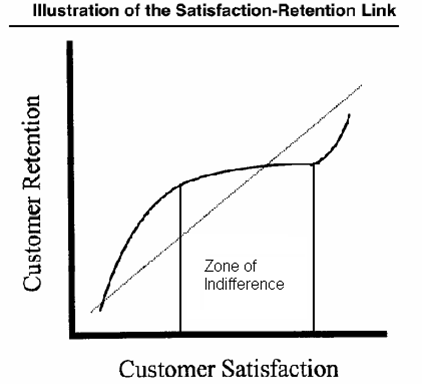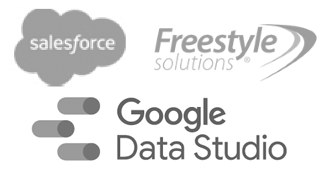The summer semester of my Johns Hopkins CRM (customer relationship management) class began anew this week. New students, new changes in the CRM marketplace, and a new curriculum that our students are finding quite exciting.
One topic generating conversation is the “Zone of Indifference,” a concept that states, as illustrated in the graph below, the link between customer satisfaction and customer loyalty is not linear. In other words, at some point, resources expended on customer satisfaction reach diminishing returns in customer retention.*
For example, the Zone of Indifference may explain why airlines can get away with serving peanuts to passengers on transcontinental flights. Perhaps airline customers believe that the benefits of frequent-flyer mileage or low prices trump an in-flight hot meal. No airline has shared their CRM strategy, so we can only assume that the industry has done its homework in assessing customer satisfaction.
Another example, perhaps more common, is the increasing practice of offering free shipping by internet retailers. From a competitive standpoint, many retailers are reluctant to take this costly overture away — principally because they suspect a reduction in response, and they don’t have a benchmark against which to test.
Our students quickly learn that testing, like many other fundamentals of direct response marketing (e.g., segmenting, targeting, and trackability), has found its way into mainstream digital marketing practice. In particular, the use of A/B split testing of online offers is now commonplace, certainly a carry-over from the days of A/B split testing of direct mail offers.
Many popular email marketing platforms — including MailChimp and our own WiseGuys Marketing package — include A/B split options.
Mini marketing lesson for newbies: A/B split testing is just like the science experiments you performed in middle school: Start by setting aside a control group (A) and another group (B). Change a factor (known as an “independent variable”) in the experience of the B group and measure the response — and thus its influence — against responses of the control group (A). For example, continue to offer free shipping to the control group and do not offer free shipping to group B. Monitor the rate of sales and measure the importance of free shipping.
Back to the Zone of Indifference — are you really sure that your free shipping policy is netting out for you? Or are a substantial number of your customers indifferent to your policy, perhaps because, like air travelers, all they expect is peanuts? A/B split testing of website offers and other promotions will help you to know under what conditions your customers are indifferent
Have more questions about A/B split testing? Contact WiseGuys Marketing staff at (703) 941-8109 — and let us show you how WiseGuys can simplify this approach.
Note: Zone of Indifference Graphic from “Customer Relationship Management”, (2nd Edition), V. Kumar; Werner Reinartz. Originally published in “Strengthening the satisfaction-profit chain”, Eugene W Anderson, Vikas Mittal. Journal of Service Research, Nov 2000. Vol 3, Iss.2, p 114.










